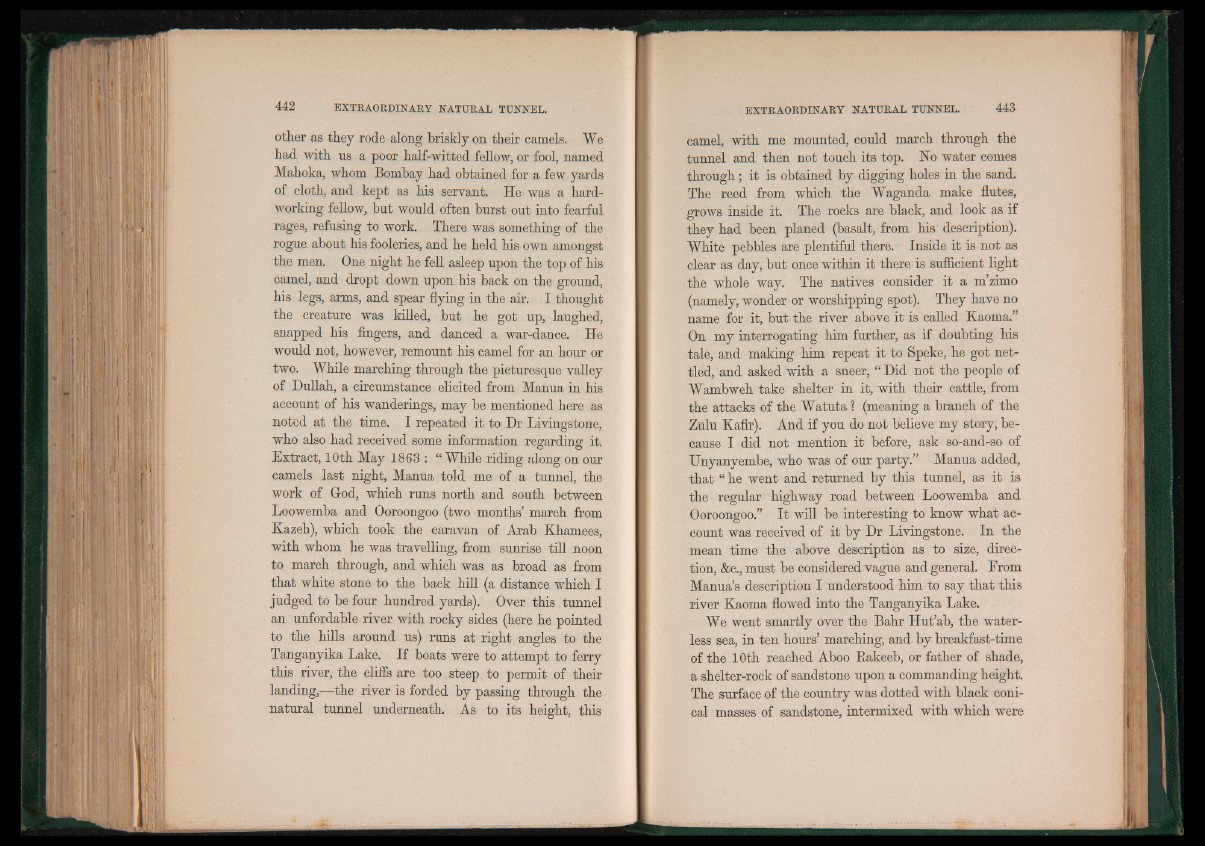
other as they rode along briskly on their camels. We
had with us a poor half-witted fellow, or fool, named
Mahoka, whom Bombay had obtained for a few yards
of cloth, and kept as his servant. He was a hardworking
fellow, but would often burst out into fearful
rages, refusing to work. There was something of the
rogue about his fooleries, and he held his own amongst
the men. One night he fell asleep upon the top of his
camel, and dropt down upon his back on the ground,
his legs, arms, and spear flying in the air. I thought
the creature was killed, but he got up, laughed,
snapped his fingers, and danced a war-danee. He
would not, however, remount his camel for an hour or
two. While marching through the picturesque valley
of Dullah, a circumstance elicited from Manua in his
account of his wanderings, may be mentioned here as
noted at the time, I repeated it to Dr Livingstone,
who also had received some information regarding it.
Extract, 10th May 1863 : “ While riding along on our
camels last night, Manua told me of a tunnel, the
work of God, which runs north and south between
Loowemba and Ooroongoo (two months’ march from
Kazeh), which took the caravan of Arab Khamees,
with whom he was travelling, from sunrise till noon
to march through, and which was as broad as from
that white stone to the back hill (a distance which I
judged to be four hundred yards). Over this tunnel
an unfordable river with rocky sides (here he pointed
to the hills around us) runs at right angles to the
Tanganyika Lake. If boats were to attempt to ferry
this river, the cliffs are too steep to permit of their
landing,—the river is forded by passing through the
natural tunnel underneath. As to its height, this
camel, with me mounted, could march through the
tunnel and then not touch its top. No water comes
through ; it is obtained by digging holes in the sand.
The reed from which the Waganda make flutes,
grows inside it. The rocks are black, and look as if
they had been planed (basalt, from his description).
White pebbles are plentiful there. Inside it is not as
clear as day, but once within it there is sufficient light
the whole way. The natives consider it a m’zimo
(namely, wonder or worshipping spot). They have no
name for it, but the river above it is called Kaoma.”
On my interrogating him further, as if doubting his
tale, and making him repeat it to Speke, he got nettled,
and asked with a sneer, “ Did not the people of
Wambweh take shelter in it, with their cattle, from
the attacks of the Watuta ? (meaning a branch of the
Zulu Kafir). And if you do not believe my story, because
I did not mention it before, ask so-and-so of
Unyanyembe, who was of our party.” Manua added,
that “ he went and returned by this tunnel, as it is
the regular highway road between Loowemba and
Ooroongoo.” It will be interesting to know what account
was received of it by Dr Livingstone. In the
mean time the above description as to size, direction,
&e., must be considered vague and general. From
Manua’s description I understood him to say that this
river Kaoma flowed into the Tanganyika Lake.
We went smartly over the Bahr Hut’ab, the waterless
sea, in ten hours’ marching, and by breakfast-time
of the 10th reached Aboo Bakeeb, or father of shade,
a shelter-rock of sandstone upon a commanding height.
The surface of the country was dotted with black conical
masses of sandstone, intermixed with which were